 W
WThe Czortków uprising was a failed attempt at resisting Soviet state repressions by the young anti-Soviet Poles most of whom were prewar students from the local high school. The uprising took place in the Soviet-occupied Polish town of Czortków during World War II. The insurgents attempted to storm the local Red Army barracks and a prison in order to release Polish soldiers incarcerated there. The attack occurred on the night of January 21–22, 1940. It was the first Polish civilian uprising against the Nazi-Soviet occupation of Poland.
 W
WThe Drama uprising was an uprising of the population of the northern Greek city of Drama and the surrounding villages on 28–29 September 1941 against the Bulgarian occupation regime. The revolt lacked organization or military resources and was swiftly suppressed by the Bulgarian Army with massive reprisals. The revolt had guidance from the Macedonian politburo of the Communist Party of Greece (KKE).
 W
WThe Georgian uprising on Texel was an insurrection by the 882nd Infantry Battalion Königin Tamara of the Georgian Legion of the German Army stationed on the German occupied Dutch island of Texel. The battalion was made up of 800 Georgians and 400 Germans, with mainly German officers. It was one of the last battles in the European theatre.
 W
WThe Maquis des Glières was a Free French Resistance group, which fought against the 1940–1944 German occupation of France in World War II. The name is also given to the military conflict that opposed Resistance fighters to German, Vichy and Milice forces.
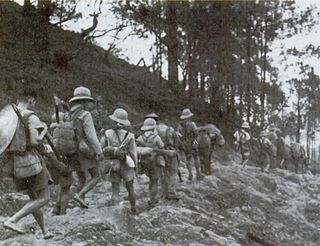 W
WThe Japanese coup d'état in French Indochina, known as Meigō Sakusen, was a Japanese operation that took place on 9 March 1945 towards the end of World War II. With Japanese forces losing the war and the threat of an Allied invasion of Indochina imminent, the Japanese were concerned about an uprising against them by French colonial forces.
 W
WThe Jewish insurgency in Mandatory Palestine, known in the United Kingdom as the Palestine Emergency, was a paramilitary campaign carried out by Zionist underground groups against British rule in Mandatory Palestine. The tensions between the Zionist underground and the British mandatory authorities rose from 1938 and intensified with the publication of the White Paper of 1939. The Paper outlined new government policies to place further restrictions on Jewish immigration and land purchases, and declared the intention of giving independence to Palestine, with an Arab majority, within ten years. Though World War II brought relative calm, the tensions again escalated into an armed struggle towards the end of the war, when it became clear that the Axis powers were close to defeat.
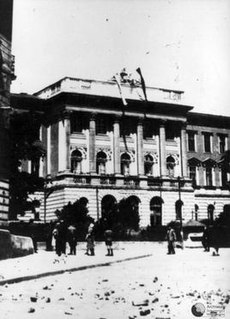 W
WThe Lwów uprising was an armed insurrection by the Home Army underground forces of the Polish resistance movement in World War II against the Nazi German occupation of the city of Lwów in the latter stages of World War II. It began on July 23, 1944 as part of a secret plan to launch the countrywide all-national uprising codenamed Operation Tempest ahead of the Soviet advance on the Eastern Front. The Lwów uprising lasted until July 27. Shortly afterwards, the Polish troops were disarmed, soldiers merged into the Polish communist armed forces and officers arrested by the Soviet NKVD. Some were forced to join the Red Army, others sent to the Gulag camps. The city itself was occupied by the Soviet Union.
 W
WThe Maquis du Mont Mouchet were a group of French resistance fighters during the Second World War that were based at Mont Mouchet.
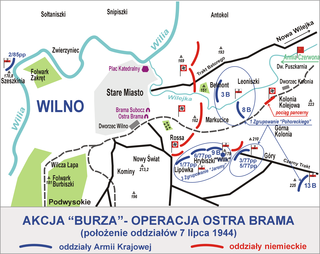 W
WOperation Ostra Brama was an attempt by the Polish Home Army to take over Vilnius from Nazi Germany's evacuating troops ahead of the approaching Soviet Vilnius Offensive. A part of a Polish national uprising, Operation Tempest, the action began on 7 July 1944 and lasted until 14 July 1944.
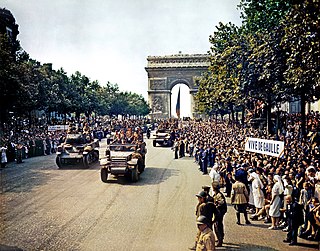 W
WThe Liberation of Paris was a military battle that took place during World War II from 19 August 1944 until the German garrison surrendered the French capital on 25 August 1944. Paris had been ruled by Nazi Germany since the signing of the Second Compiègne Armistice on 22 June 1940, after which the Wehrmacht occupied northern and western France.
 W
WThe Prague uprising of 1945 was a partially successful attempt by the Czech resistance to liberate the city of Prague from German occupation during World War II. The preceding six years of occupation had fuelled anti-German sentiment and the approach of the Soviet Red Army and the US Third Army offered a chance of success.
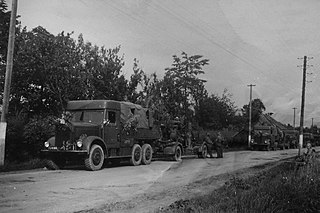 W
WThe Slovak National Uprising was an armed insurrection organized by the Slovak resistance movement during World War II. This resistance movement was represented mainly by the members of the Democratic Party, but also by social democrats and Communists, albeit on a smaller scale. It was launched on 29 August 1944 from Banská Bystrica in an attempt to resist German troops that had occupied Slovak territory and to overthrow the collaborationist government of Jozef Tiso. Although the resistance was largely defeated by German forces, guerrilla operations continued until the Soviet Army, Czechoslovak Army and Romanian Army liberated Fascist Slovakia in 1945.
 W
WThe Uprising in Montenegro (Montenegrin: Ustanak u Crnoj Gori), commonly known as the 13 July Uprising (Montenegrin: Trinaestojulski ustanak) was an uprising against Italian occupation forces in Montenegro. Initiated by the Communist Party of Yugoslavia on 13 July 1941, it was suppressed within six weeks, but continued at a much lower intensity until December 1941. The insurgents were led by a combination of communists and former Royal Yugoslav Army officers from Montenegro. Some of the officers had recently been released from prisoner-of-war camps following their capture during the invasion of Yugoslavia. The communists managed the organisation and provided political commissars, while the insurgent military forces were led by former officers. The entire nation rejected the privileged position offered by its occupiers, rejected the capitulation in order to fight for Yugoslavia, together with "Russia".
 W
WThe Maquis du Vercors was a rural group of the French Forces of the Interior (FFI) (maquis) that resisted the 1940–1944 German occupation of France in World War II. The Maquis du Vercors used the prominent scenic plateau known as the Massif du Vercors as a refuge. Initially the maquis carried out only sabotage and partisan operations against the Germans, but after the Normandy Invasion on 6 June 1944, the leadership of an army of about 4,000 maquis declared the "Free Republic of Vercors," raised the French flag, and attempted to create a conventional army to oppose the German occupation.
 W
WThe Warsaw Uprising was a major World War II operation, in the summer of 1944, by the Polish underground resistance, led by the Polish resistance Home Army, to liberate Warsaw from German occupation. The uprising was timed to coincide with the retreat of the German forces from Poland ahead of the Soviet advance. While approaching the eastern suburbs of the city, the Red Army temporarily halted combat operations, enabling the Germans to regroup and defeat the Polish resistance and to destroy the city in retaliation. The Uprising was fought for 63 days with little outside support. It was the single largest military effort taken by any European resistance movement during World War II.
 W
WThe Zamość uprising comprised World War II partisan operations, 1942–1944, by the Polish resistance against Germany's Generalplan-Ost forced expulsion of Poles from the Zamość region (Zamojszczyzna) and the region's colonization by German settlers.